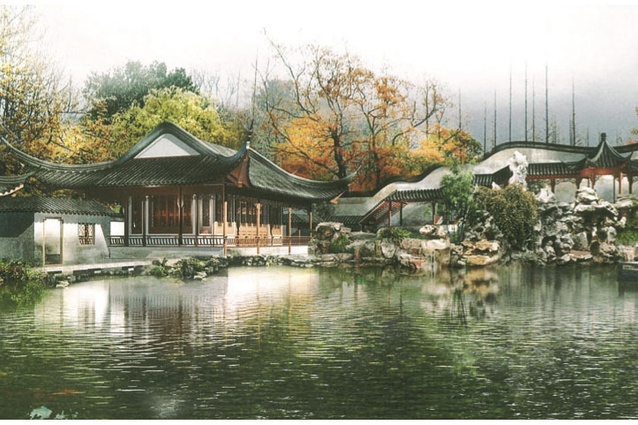From the outside in
Cissy Zhang, a recent Masters in Interior Architecture graduate, talks us through the the process of putting together her final-year thesis.
Cissy, how did you settle on the subject for your thesis?
I left my native country of China in 2003 to attend high school and university in New Zealand. Over time, I felt my Chinese cultural essence fading. However, my interest in traditional Chinese architecture never died away, so this was a great opportunity for me to learn and explore more about China, and regain an understanding of what elements are embodied in the Chinese architectural design.
What, eventually, did you define as your subject matter?
My research proposal was aimed at investigating Japanese culture, Japanese gardens and some contemporary architecture designed by Tadao Ando in order to discover how Ando managed to translate the cultural philosophies into contemporary architectural language. I thought Chinese cultural imperatives could be similarly retained, translated, and celebrated in contemporary Chinese interior architectural design based on Ando’s methods. Therefore, it was essential to research Chinese culture, gardens and contemporary Chinese architecture to experience how a contemporary interior architecture could be inspired by the philosophy and principles of traditional Chinese gardens within a contemporary Western environment.
Did you need to travel to do researching?
Yes, I spent one month travelling in Japan and China. The first 10 days were in Japan, with my best friend who lives there. She took me to experience and explore the local culture, some elegant Japanese gardens and Ando’s architectural projects in Osaka, Kyoto and Nagoya. The rest of the time I spent in China, researching similar aspects. There are four major Chinese gardens types, the Imperial Garden, Private Garden, Monastery Garden and Scenic Resort Garden. They can be found in different parts of China but all the major ones are located in Beijing, Jiangsu and Zhejiang provinces. I travelled to Beijing, Suzhou, Zhouzhuang for my research of traditional Chinese gardens, as well as some other major cities like Shanghai, Shenzhen and Chongqing for a feeling of contemporary architecture.
There is also a ‘challenge’ aspect to the thesis work isn’t there – where you a required to select a site and produce a design scenario?
Yes, I selected the waterfront site of Frank Kitts Park, in Wellington as my site for the design challenge. interestingly, Wellington Waterfront has decided to incorporate a real Chinese garden here, which is designed by Wraight + Assocaites landscape architects. It will be considered as a symbol of the close relationship between Wellington and its sister cities of Beijing and Xiamen. I interviewed the chairman of the Wellington Chinese Garden Society and learned if they were concerned about a Chinese Garden being designed and incorporated into a Western site. My design experience challenges were to take any ‘negatives’ of the existing conditions and translate them into positives through Chinese garden making theories and philosophies. I also investigated the Dunedin Chinese Garden. That design hides the western urban context behind a surrounding wall; my design thesis seeks to embrace the surrounding western urban context and incorporate it into the garden.
So, in summary, what were the key points of your research and findings?
This whole thesis used an iconic Chinese architectural symbol, the ‘Chinese Garden’, as a vehicle to explore this opportunity to re-interpret the traditional Chinese garden in relation to contemporary Chinese urban culture. This thesis explored four major Chinese garden types and their architectural characteristics, how their imperative cultural reflections of Confucianism, Taoism, Buddhism, Fengshui Principles, and Chinese landscape Painting which influenced traditional Chinese garden making. This thesis analysed the qualities of the existing site, Frank Kitts Park, and discussed the important ‘positives’ and potential ‘negatives’ that exist on the site.
This design challenged how a contemporary and western context can be incorporated with the principles of a traditional Chinese garden and how existing urban elements can be interpreted as landscape elements by translating traditionally soft plant elements into architectural elements. Just as solid walls are used to enclose the perimeter of traditional style gardens, the contemporary garden should also consider the application of physical walls in order to divide space and thus create multiple discreet spaces which may be considered as an inner and outer world with a garden boundary at ground level; a spiritual inner world is found within the garden and a literal outer world remains outside of the garden walls.
Your thesis is interesting in that it focuses on Chinese and Japanese gardens, but you are studying interior archiecture. What is the relationship to field of interior architecture?
Interior architecture is a new trend in the architectural field; it is unlike the interior decoration which is only about dressing and decorating interior spaces. Rather, it’s about architectural tectonics, holistic spatial planning, installations, surfaces and details. Interior architecture is more about the merging of spaces – spaces being neither exterior nor interior. My design intervention demonstrated that ‘interiority’ is not necessarily limited by geometry, form, time, and space – but can also be generated through the natural environment on open ground without an outer building envelope. ‘Interiority’, also, could be an ephemeral space, enclosed by the elements of air and sound; it could also be a ‘reciprocal interaction’ between buildings and landscape, originating from the ambiguous treatment of figure and ground. Exteriors become interiors, and interiors become exteriors.











